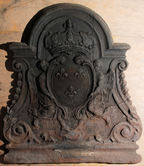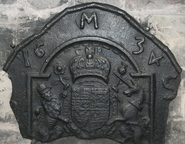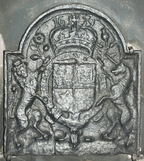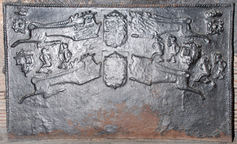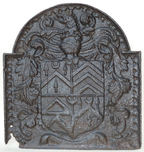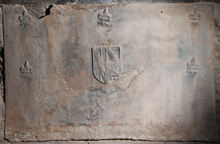-
189
Description: Rectangular with an ogee arch; twisted rope edging (top and sides); line of small fleurs-de-lys around the top and sides, inside the edging; Tudor rose inside each top corner (overstamped on the left); below each rose an escarbuncle of twisted rope with fleur de lys terminals (understamped); top centre, a Tudor royal shield within an oval garter - HONE SOVT QUEY MAL Y PENSE - with greyhound and lion supporters, and crown above; cross of small fleurs inclined to each side of the crown; inverted 'Y' shape in twisted rope below each supporter, a fleur at the top end of each.
Notes: An oft-used achievement of arms; twisted rope with fleur de lys terminals are seen on other firebacks from the same source. The escarbuncle was the principal charge on the arms of the Duchy of Cleves, the same charge on this fireback possibly associating it with the brief marriage of Henry VIII and Anne of Cleves.
Inscription: HONE SOVT QUEY MAL Y PENSE
Arms: Tudor royal (prob. Henry VIII)
- Decoration tags:
- rectangular with ogee-arch (shape)
- rope (edging)
- carved stamps
- heraldic
- armorial
- royal
- text
- objects
Manufactured: in the mid- to late-16th century possibly at Pounsley Furnace, Framfield in the Weald area of England.
Current location: in private hands, Hatfield, Hertfordshire, England.
- Attached to series:
- Pounsley series
- Fleur rope terminal series
- Tudor royal armorial firebacks
-
191
Description: Arched rectangle; cavetto moulded edging; Tudor royal shield, Garter and crown, with crowned lion and dragon supporters; motto along bottom; Tudor rose to left of crown, portcullis to right.
Notes: This painted fireback is reputed to have been a gift from King Henry VIII to the second Sir William Godolphin, who was present at the Siege of Boulogne in 1544 with a party of Godolphin tin miners.
Copies of this fireback are known.
Inscription: HONI SOIT QVI MAL E PENSE / DIEU ET MON DROIT
Arms: Tudor royal (Elizabeth I)
- Decoration tags:
- rectangular with round arch (shape)
- cavetto (edging)
- whole carved pattern
- armorial
- text
Manufactured: in the mid- to late-16th century possibly in the Weald area of England.
Current location: Godolphin House, Helston, Cornwall, England.
Museum number: 169480 (part of the National Trust museum group)
- Attached to series:
- Tudor royal armorial firebacks
-
938
Description: Rectangular with three-facetted arch; fillet edging; shield, crown and lion supporters of the French royal house of Valois.
Notes: The arms date to before 1589 when the House of Valois was succeeded by the House of Bourbon. Lion supporters on the French royal arms are not common.
Arms: France Royal
- Decoration tags:
- rectangular with three-facetted arch (shape)
- fillet (edging)
- whole carved pattern
- planklines
- armorial
Manufactured: in the late-16th century in France.
Current location: not known.
- Attached to series:
- Foreign armorial firebacks
-
939
Description: Rectangular with triangular top; ovolo-moulded edging; shield and crown of the French royal house of Valois, encircled by the collars of the orders of Saint Michel and Saint-Esprit
Notes: Cast no later than 1589 when the House of Valois was succeeded by the House of Bourbon.
Arms: France Royal
- Decoration tags:
- triangular arched (shape)
- ovolo (edging)
- whole carved pattern
- planklines
- armorial
Manufactured: in the late-16th century in France.
Current location: not known.
- Attached to series:
- Foreign armorial firebacks
-
940
Description: Upon a rectangular base plinth, wide scrolled side fillets with foliage about the scrolls and suspended bell flowers in chain above; central oval shield bearing three fleurs-de-lys supported by an angel on each side, and surmounted by a French royal crown; on top, an arch rising from horizontal moulding on each side.
Notes: Characteristic of designs illustrated by architects such as Daniel Marot.
Arms: France Royal
- Decoration tags:
- rectangular with round arch (shape)
- complex individual (edging)
- whole carved pattern
- planklines
- armorial
- royal
Manufactured: in the late-17th to early-18th century in France.
Current location: not known.
- Attached to series:
- Foreign armorial firebacks
-
1076
Description: Fragment; arched rectangular fireback with embattled, cavetto-moulded edging; English Stuart royal shield, Garter, crown and supporters, stemmed rose and stemmed thistle, respectively, to left and right of crown; initials CR above crown; all within a plain border, with short lengths of twisted rope edging containing, at the top, the initial M between a split date; initials (only S surviving) below date.
Notes: A Carolean composite fireback. The armorial fireback includes stylistic elements - the form of the unicorn and of the harp - identical to those on two series of firebacks dated 1618 and 1619, indicating the work of the same pattern-maker; its width is 490mm.
Inscription: M / 1634 / [?] S / C R
Arms: English Stuart royal (Charles I)
- Decoration tags:
- rounded arched (shape)
- rope (edging)
- carved pattern panels
- composite
- individual letters
- individual numbers
- heraldic
- armorial
- text
Manufactured: in 1634 possibly in the Forest of Dean area of England.
Current location: Black and White House Museum, The Old House, High Town, Hereford, Herefordshire, England.
-
1075
Description: Arched rectangular shape; cavetto-moulded edging (top and sides); English Stuart Royal arms, garter, supporters, crown and motto; altered date above crown.
Notes: This design, which probably dates from 1619, has been used to cast composite firebacks with a variety of altered dates ranging from 1629 to 1662.
Copies of this fireback are known.
Inscription: 1639 [illegible Garter and royal mottoes]
Arms: English Stuart royal
- Decoration tags:
- rectangular with round arch (shape)
- cavetto (edging)
- whole carved pattern
- individual numbers
- heraldic
- armorial
- text
Manufactured: in 1639 in the Forest of Dean area of England.
Current location: Black and White House Museum, The Old House, High Town, Hereford, Herefordshire, England.
-
322
Description: Rectangular; rope edging (top and sides); two central crowned Tudor shields, one above the other, each with lion passant guardant sinister to the left, and lion passant to right; crowned, barbed, four-petalled rose in right and left corners; two crowned shields with KH in Lombardic characters above a fleur de lys, each irregularly placed between lions on left and right sides; three 'imps' with right arm raised, two on right and one on left between lions; two ‘imps’ with both arms lowered, one on each side in similar positions.
Notes: One of the legs of the leopards on the right is missing, suggesting that the stamp, which appears complete on many firebacks, was well used and had been damaged; this suggests a relatively late use of these stamps. The same heraldic charges can be seen on other firebacks, with other charges, forming the decoration on many other firebacks, suggesting they were the stock of one particular furnace.
Arms: Tudor royal arms of England
- Decoration tags:
- rectangular (shape)
- rope (edging)
- carved stamps
- heraldic
- armorial
- royal
- animals
Manufactured: in the mid- to late-16th century in the Weald area of England.
Current location: Hever Castle, Hever, Kent, England.
- Attached to series:
- Royal series
-
915
Description: Rectangular with superimposed arch; embattled, cavetto-moulded edging, with the top edge of the rectangle interrupted; quartered shield, helm, crest and mantling.
Notes: The arms appear to be those of the family of Armeston of Burbage, Leicestershire, possibly Thomas Armeston (c1606-85), 2nd son of Thomas Armeston (d.1640), sometime MP for Leicestershire: 1st and 4th (Armeston) sable a chevron between three spear heads argent with a crescent for difference, 2nd (unknown) three chevronels with a rose in a canton, 3rd (unknown) a fess between two chevronels, a crescent for difference over all. The Armeston crest is a dragon's head erased vert scaled or and charged with a crescent of the same for difference; the crescent is the mark of cadency for the second son; in this instance the arms appear to be of a second son descended from a second son in an earlier generation. The embattled edging and superimposed arch are features of a series of firebacks dated 1619. However, the style of the mantling is typical of a small group of firebacks noted in Herefordshire.
Arms: Armeston, of Burbage, Leicestershire
- Decoration tags:
- rectangular with round arch (shape)
- embattled cavetto (edging)
- whole carved pattern
- armorial
Manufactured: in the early- to mid-17th century in England.
Current location: in private hands, Honiton, Devon, England.
- Attached to series:
- Personal armorial firebacks
- Herefordshire armorial series
-
951
Description: Rectangular; central shield; fleur-de-lys stamp repeated three times across top and once on each side level with shield, all regularly spaced.
Notes: It is likely that the arms relate to the marriage, in 1541, of Christopher Sackville (c.1519-1559), son of John Sackville of Chiddingly, Sussex, and Constance Colepeper, daughter of Thomas Colepeper of Bedgebury, Kent, one of whose ancestors was the heiress, Elizabeth Hardreshull. The blazon: Sackville - quarterly or and gules, a bend vair; Colepeper - argent a bend engrailed gules; Hardreshull - argent a chevron sable between nine martlets gules, six and three. Christopher Sackville's brother, Sir Richard, owned Horsted Keynes furnace, which may have been where this fireback was cast. A candidate for the earliest English fireback with an example of personal arms.
Arms: Sackville impaling Colepeper and Hardreshall
- Decoration tags:
- rectangular (shape)
- none (edging)
- carved stamps
- heraldic
- armorial
Manufactured: in the mid-16th century possibly at Horsted Keynes Furnace in the Weald area of England.
Current location: in private hands, Horsted Keynes, West Sussex, England.
- Attached to series:
- Personal armorial firebacks
- Sackville firebacks




